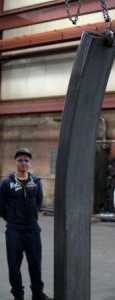Square and rectangular tube bending, though a common practice, is wrought with many challenges. The hollow structure of a tube makes it more likely to fall victim to distortion problems such as growth, shrinkage, concavity, and oil canning. And bending square and rectangular tubing is more difficult than bending round tubing and pipe. Round tubing and pipe can be more easily and more fully encapsulated within the bending dies than square and rectangular tubing. This is true whether the bending is done on rotary-draw benders, three-roll benders, or ram benders.
When the curved parts are to be used in construction, it is imperative that the steel fabricator and the bender/roller communicate exactly how the parts are to be oriented. Are the square tubes rolled against one of the sides or off-axis? Are the rectangular tubes rolled against the strong axis or the weak axis? Or are they to be rolled off-axis? Equally important is whether or not these curved tubes are architecturally exposed (AESS).

Preventative measures that can be taken include increasing the wall thickness of the tube to help reduce or totally eliminate the risk of oil canning and concavity. In doing so you would need to take into consideration the increased weight, and how it affects your application.
It is equally important to convey expectations when the curved pipe or tubing is to be used as component parts of machinery and equipment. For example, some original equipment manufacturers (OEMs) actually prefer to have concavity on the inside radius of the bent part: a design that actually makes the steel section stronger in this application.
By communicating this information and conveying expectations clearly, many problems can be prevented. And solutions to expected problems can be resolved ahead of time making the process timelier, less frustrating, and more cost effective.
This sharing of technical information such as orientation, radius, and arc length as well as end use and expectations goes a long way in insuring that your final product will be what you and your customer expect it to be.







